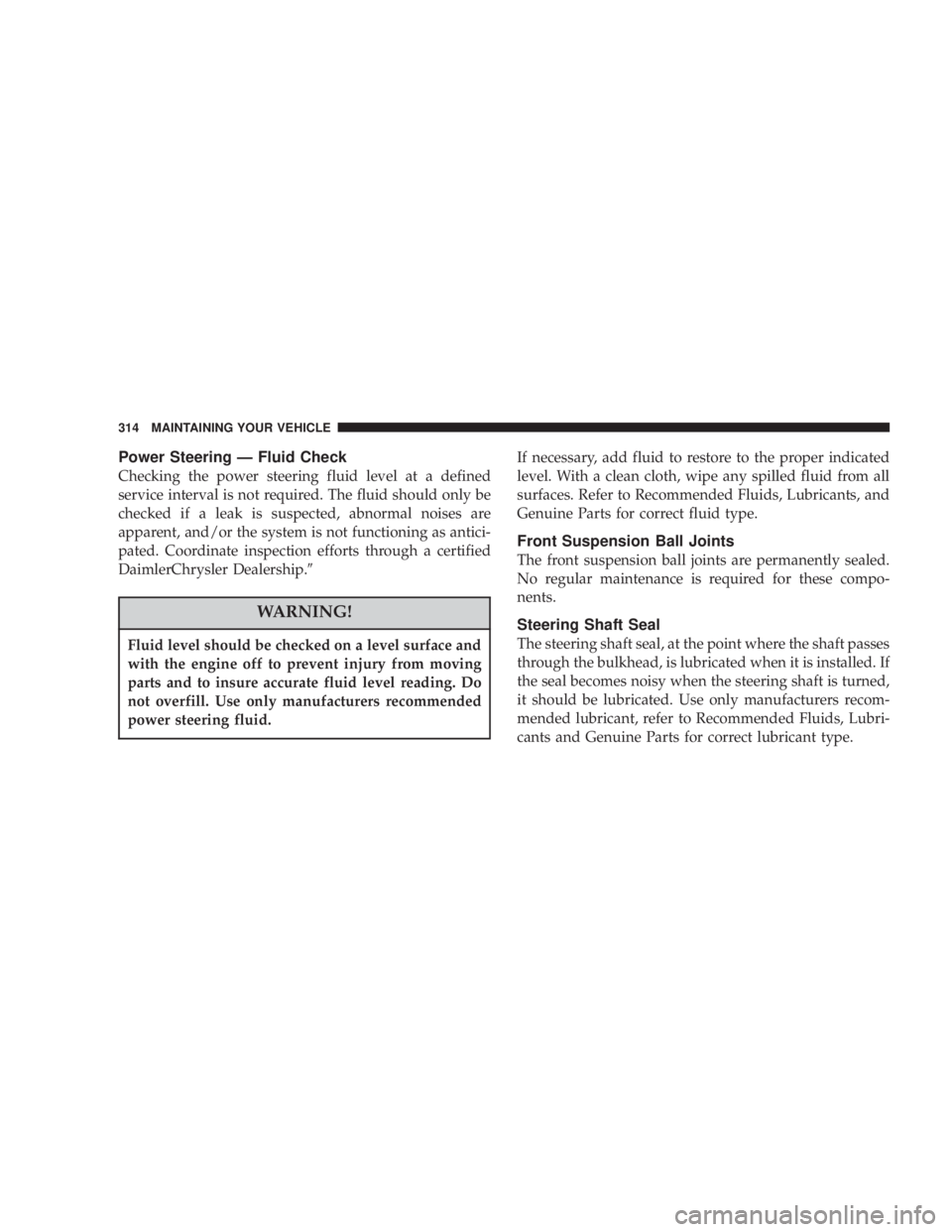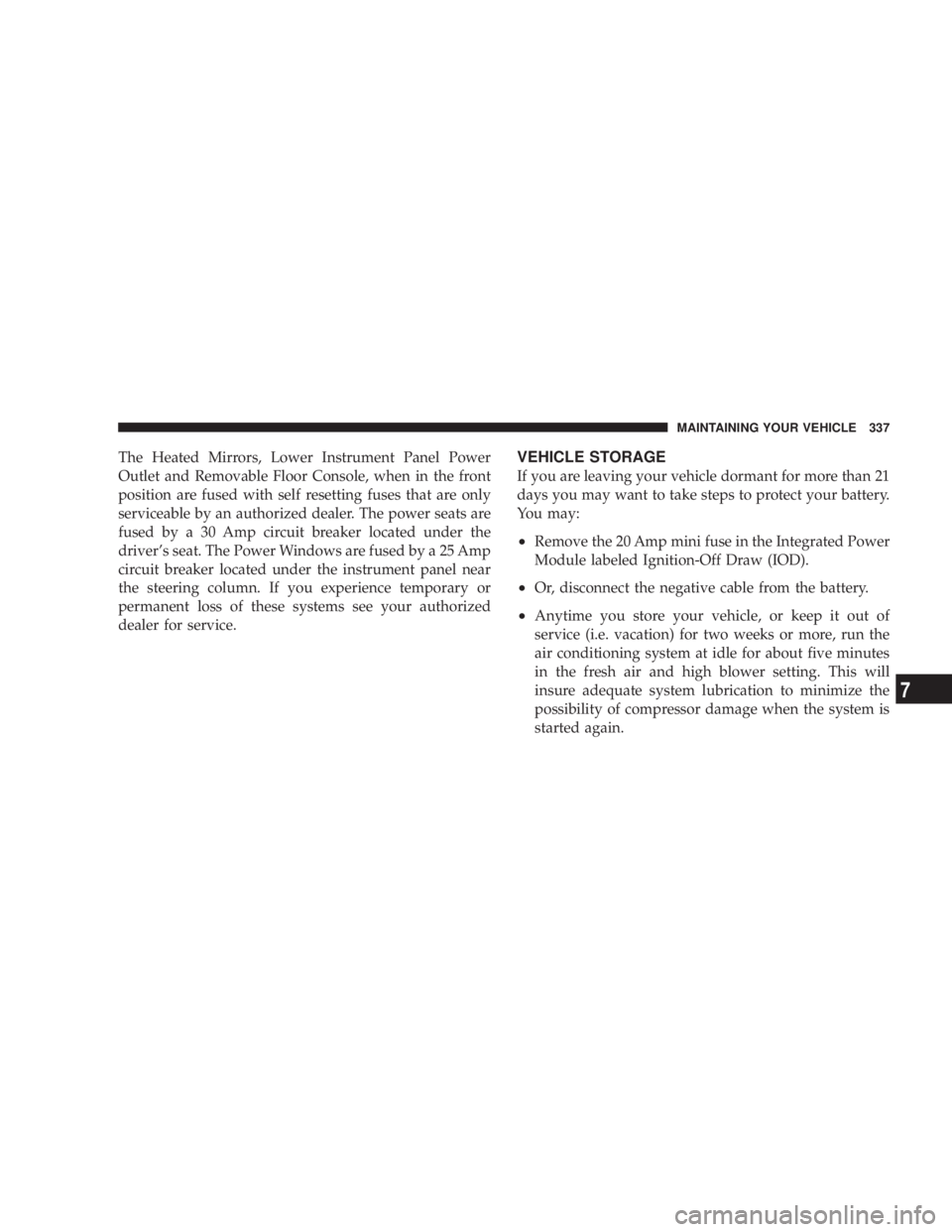Page 314 of 397

Power Steering Ð Fluid Check
Checking the power steering fluid level at a defined
service interval is not required. The fluid should only be
checked if a leak is suspected, abnormal noises are
apparent, and/or the system is not functioning as antici-
pated. Coordinate inspection efforts through a certified
DaimlerChrysler Dealership. 9
WARNING!Fluid level should be checked on a level surface and
with the engine off to prevent injury from moving
parts and to insure accurate fluid level reading. Do
not overfill. Use only manufacturers recommended
power steering fluid. If necessary, add fluid to restore to the proper indicated
level. With a clean cloth, wipe any spilled fluid from all
surfaces. Refer to Recommended Fluids, Lubricants, and
Genuine Parts for correct fluid type.
Front Suspension Ball Joints
The front suspension ball joints are permanently sealed.
No regular maintenance is required for these compo-
nents.
Steering Shaft Seal
The steering shaft seal, at the point where the shaft passes
through the bulkhead, is lubricated when it is installed. If
the seal becomes noisy when the steering shaft is turned,
it should be lubricated. Use only manufacturers recom-
mended lubricant, refer to Recommended Fluids, Lubri-
cants and Genuine Parts for correct lubricant type.314 MAINTAINING YOUR VEHICLE
Page 323 of 397

Insure nylon tubing in these areas has not melted or
collapsed.
Inspect all hose connections such as clamps and cou-
plings to make sure they are secure and no leaks are
present.
Components should be replaced immediately if there is
any evidence of wear or damage that could cause failure.
Brakes
In order to assure brake system performance, all brake
system components should be inspected periodically.
Suggested service intervals can be found in the Mainte-
nance Schedules. WARNING!Riding the brakes can lead to brake failure and
possibly an accident. Driving with your foot resting
or riding on the brake pedal can result in abnormally
high brake temperatures, excessive lining wear, and
possible brake damage. You wouldn't have your full
braking capacity in an emergency.
Brake And Power Steering Hoses
When the vehicle is serviced for scheduled maintenance,
inspect surface of hoses and nylon tubing for evidence of
heat and mechanical damage. Hard and brittle rubber,
cracking, tears, cuts, abrasion, and excessive swelling
indicate deterioration of the rubber. Particular attention
should be made to examining those hose surfaces nearest
to high heat sources, such as the exhaust manifold. MAINTAINING YOUR VEHICLE 323
7
Page 324 of 397

Insure nylon tubing in these areas has not melted or
collapsed.
Inspect all hose connections such as clamps and cou-
plings to make sure they are secure and no leaks are
present.
NOTE: Often, fluid such as oil, power steering fluid,
and brake fluid are used during assembly plant opera-
tions to facilitate the assembly of hoses to couplings.
Therefore, oil wetness at the hose-coupling area is not
necessarily an indication of leakage. Actual dripping of
hot fluid when systems are under pressure (during
vehicle operation), should be noted before hose is re-
placed based on leakage.
NOTE: Inspection of brake hoses should be performed
whenever the brake system is serviced and every engine
oil change. Inspect hydraulic brake hoses for surface
cracking, scuffing, or worn spots. If there is any evidence
of cracking, scuffing, or worn spots, the hose should be replaced immediately! Eventual deterioration of the hose
can take place resulting in a possibility of a burst failure.
WARNING!Worn brake hoses can burst and cause brake failure.
You could have an accident. If you see any signs of
cracking, scuffing, or worn spots, have the brake
hoses replaced immediately.
Master Cylinder Ð ABS Brakes Brake Fluid Level
Check
The fluid level in the master cylinder should be checked
when performing underhood services, or immediately if
the brake system warning light indicates system failure.
Clean the top of the master cylinder area before removing
the cap. Add fluid to bring the level up to the top of the
ªFULLº mark on the side of the master cylinder reservoir.324 MAINTAINING YOUR VEHICLE
Page 337 of 397

The Heated Mirrors, Lower Instrument Panel Power
Outlet and Removable Floor Console, when in the front
position are fused with self resetting fuses that are only
serviceable by an authorized dealer. The power seats are
fused by a 30 Amp circuit breaker located under the
driver's seat. The Power Windows are fused by a 25 Amp
circuit breaker located under the instrument panel near
the steering column. If you experience temporary or
permanent loss of these systems see your authorized
dealer for service. VEHICLE STORAGE
If you are leaving your vehicle dormant for more than 21
days you may want to take steps to protect your battery.
You may:
² Remove the 20 Amp mini fuse in the Integrated Power
Module labeled Ignition-Off Draw (IOD).
² Or, disconnect the negative cable from the battery.
² Anytime you store your vehicle, or keep it out of
service (i.e. vacation) for two weeks or more, run the
air conditioning system at idle for about five minutes
in the fresh air and high blower setting. This will
insure adequate system lubrication to minimize the
possibility of compressor damage when the system is
started again. MAINTAINING YOUR VEHICLE 337
7
Page 345 of 397
Chassis
Component Fluids, Lubricants and Genuine Parts.
Automatic Transmission Mopar t ATF+4 Automatic Transmission Fluid.
AWD Power Transfer Unit Mopar t Gear Lubricant 75W-90.
AWD Overrunning Clutch Mopar t ATF+4 Automatic Transmission Fluid.
AWD Rear Carrier Mopar t Gear Lubricant 75W-90.
Brake Master Cylinder Mopar t DOT 3 and SAE J1703 should be used. If DOT 3 brake fluid is not
available, then DOT 4 or DOT 4+ is acceptable. Use only recommended
brake fluids.
Power Steering Reservoir Mopar t ATF+4 Automatic Transmission Fluid. MAINTAINING YOUR VEHICLE 345
7
Page 352 of 397
Miles 3, 000 6, 000 9, 000 12, 000 15, 000 18, 000
(Kilometers) (5 000 ) (10 000 ) (14 000) (19 000) (24 000) (29 000)
Change engine oil and engine oil filter. XXXXX X
Inspect the brake linings. X X
Inspect the engine air cleaner filter, replace if
necessary. * XXXX X
Replace the engine air cleaner filter. *X
Inspect and adjust the power steering pump
belt tension on 2.4 liter engines. X
Inspect the generator belt on 2.4 liter engines,
replace if necessary. X
Change the All Wheel Drive (AWD) power
transfer unit fluid. (See note at the end of this
chart) X
Replace the air conditioning filter. X 352 SCHEDULE ªBº
8 M
A
I
N
T
E
N
A
N
C
E
S
C
H
E
D
U
L
E
S
Page 353 of 397
Miles 21, 000 24, 000 27, 000 30, 000 33, 000 36, 000
(Kilometers) (34 000) (38 000) (43 000) (48 000) (53 000) (58 000)
Change engine oil and engine oil filter. XXXXX X
Inspect the brake linings. X X
Inspect the engine air cleaner filter, replace if
necessary. * XXX X X
Replace the engine air cleaner filter. X
Replace the spark plugs 2.4 liter engines. X
Inspect the tie rod ends and boot seals. X
Inspect and adjust the power steering pump
belt tension on 2.4 liter engines. X
Inspect the generator belt on 2.4 liter engines,
replace if necessary. X
Inspect the PCV valve and replace as neces-
sary.* X
Change the All Wheel Drive (AWD) power
transfer unit fluid. (See note at the end of this
chart) X SCHEDULE ªBº 353
8 M
A
I
N
T
E
N
A
N
C
E
S
C
H
E
D
U
L
E
S
Page 355 of 397
Miles 39, 000 42, 000 45, 000 48, 000 51, 000 54, 000
(Kilometers) (62 000) (67 000) (72 000) (77 000) (82 000) (86 000)
Change engine oil and engine oil filter. XXXXX X
Inspect the brake linings. X X
Inspect the engine air cleaner filter, replace if
necessary. * XX XX X
Replace the engine air cleaner filter. *X
Inspect and adjust the power steering pump
belt tension on 2.4 liter engines. X
Inspect the generator belt on 2.4 liter engines,
replace if necessary. X
Change the All Wheel Drive power transfer
unit fluid. (See the note at the end of this
chart.) X
Change the All Wheel Drive (AWD) overrun-
ning clutch and rear carrier fluid. (See note at
the end of this chart) X
Replace the air conditioning filter. X SCHEDULE ªBº 355
8 M
A
I
N
T
E
N
A
N
C
E
S
C
H
E
D
U
L
E
S